托福TPO1-19难度分析(实用)
托福TPO的难度与真实考试差别多大

托福TPO的难度与真实考试差别多大2017.9.17考试成绩出来了,来完善答案。
三次托福考试经验,第一次阅读22分、听力18分,口语19分、写作21分。
第二次阅读27分、听力23分、口语20分、写作23分。
第三次阅读29分、听力26分、口语22分、写作25分。
听力部分,评价TPO的难度是否与真题相当,应该从两个方面来说。
(1)听力材料难度。
如果让我选一套TPO听力材料与真题难度相当的TPO我会选TPO22(因为暂时想不起来其他的)。
(2)题目难度。
必须要承认的是大部分TPO的题目难度较真题简单,真题细节题更多,某一个Lecture有两个双选题在真题里面应该是常态(两次均遇到);而TPO中几乎没有哪一个Lecture题目设有两道双选题。
题设的另一方面就是,真题的四个选项更具有迷惑性,有时候听个大概很难判断真确选项。
小结:战术战略上都要高度重视听力,决不可小觑实战听力。
备考期间每三天4小时听力时间一定要保证。
阅读部分,这方面只能说个大概印象,因为我几乎没有怎么做过TPO 的阅读(如果你要考GRE的话,建议直接走GRE阅读训练比较好)。
整体印象,TPO阅读材料和题目基本与真题难度相当(可能有的要稍难一些)。
但是应该不是按照你错一个扣一分这么算分的,25分可能错5个小题2个六选三都能拿得到。
小结,管他真题还是TPO,看懂文章才是王道!总结,(1)TPO模拟分数很重要,但不是最重要的;最重要的是英语能力的进步。
如果考试之前你能明显感觉到听说读写都有能力上的提升,那这次你肯定能有很好的成绩突破。
(2)一定好好利用TPO50,TPO36-39,这几套后出的TPO(尤其是听力)能很好的反映你在考场的成绩。
(3)找不到一些TOEFL资料的(我可能会有)或者需要备考意见的朋友可以私信我,尽量及时回复。
(4)祝大家杀T杀G愉快,早日分手。
tpo难度
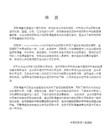
1-10简单。前面可以随意做。其中4的对话难,5的天文学和化学难。6的经济学难。8,9整体难,甚至比后面新题和考场的题目都难。
11,简单,可以不做。12难的奇怪。它是文章语音难,但是出题很简单。特别是opera的讲座。可以做做。
13,14一般。14的最后一个讲座考古学,语音很难,题目还可以。
有的只是录音难的,没有特别指明。
现在考试都是选项很难。所以大家要多注意分析选项。
我的原创哈
推荐。
15羊皮纸超难,地质还可以录音难题目不难。
16山洞难(里面也有简单的16 的钢琴就简单。)
17,18一般。
19难。19的天文学植物话题和最后一个艺术话题很难。
20一般,21-23难。24一般。25-30后面的题目基本是一般和难。和考试难度类似。其中25,29相对容易。
所谓的难度是只题目和选项的综合难度,或者是说有的是选项难。
托福TPO19详解
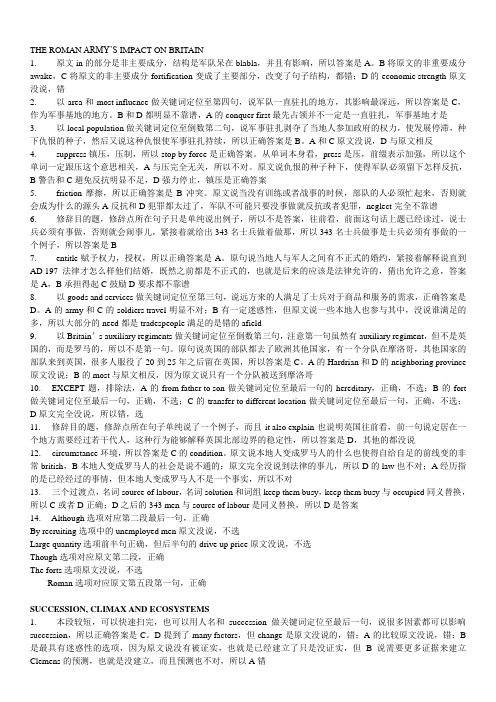
THE ROMAN ARMY’S IMPACT ON BRITAIN1. 原文in的部分是非主要成分,结构是军队呆在blabla,并且有影响,所以答案是A。
B将原文的非重要成分awake,C将原文的非主要成分fortification变成了主要部分,改变了句子结构,都错;D的economic strength原文没说,错2. 以area和most influence做关键词定位至第四句,说军队一直驻扎的地方,其影响最深远,所以答案是C,作为军事基地的地方。
B和D都明显不靠谱,A的conquer first最先占领并不一定是一直驻扎,军事基地才是3. 以local population做关键词定位至倒数第二句,说军事驻扎剥夺了当地人参加政府的权力,使发展停滞,种下仇恨的种子,然后又说这种仇恨使军事驻扎持续,所以正确答案是B。
A和C原文没说,D与原文相反4. suppress镇压,压制,所以stop by force是正确答案。
从单词本身看,press是压,前缀表示加强,所以这个单词一定跟压这个意思相关,A与压完全无关,所以不对。
原文说仇恨的种子种下,使得军队必须留下怎样反抗,B警告和C避免反抗明显不足,D强力停止,镇压是正确答案5. friction摩擦,所以正确答案是B冲突。
原文说当没有训练或者战事的时候,部队的人必须忙起来,否则就会成为什么的源头A反抗和D犯罪都太过了,军队不可能只要没事做就反抗或者犯罪,neglect完全不靠谱6. 修辞目的题,修辞点所在句子只是单纯说出例子,所以不是答案,往前看,前面这句话上题已经读过,说士兵必须有事做,否则就会闹事儿,紧接着就给出343名士兵做着做那,所以343名士兵做事是士兵必须有事做的一个例子,所以答案是B7. entitle赋予权力,授权,所以正确答案是A。
原句说当地人与军人之间有不正式的婚约,紧接着解释说直到AD 197法律才怎么样他们结婚,既然之前都是不正式的,也就是后来的应该是法律允许的,猜出允许之意,答案是A,B承担得起C鼓励D要求都不靠谱8. 以goods and services做关键词定位至第三句,说远方来的人满足了士兵对于商品和服务的需求,正确答案是D。
TPO程度分类
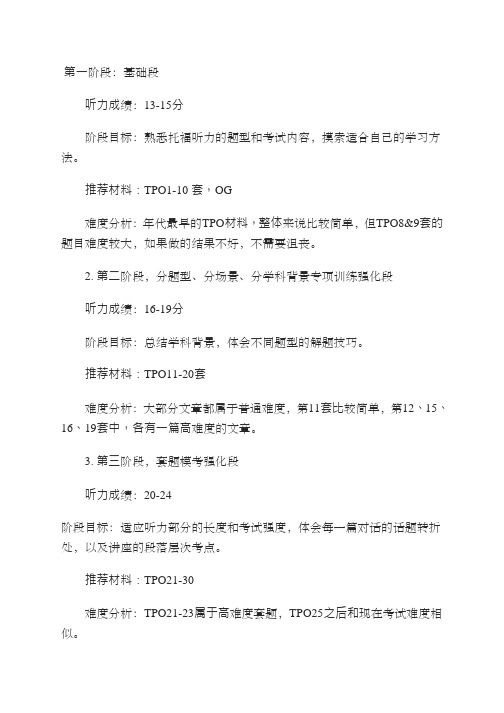
第一阶段:基础段
听力成绩:13-15分
阶段目标:熟悉托福听力的题型和考试内容,摸索适合自己的学习方法。
推荐材料:TPO1-10 套,OG
难度分析:年代最早的TPO材料,整体来说比较简单,但TPO8&9套的题目难度较大,如果做的结果不好,不需要沮丧。
2. 第二阶段,分题型、分场景、分学科背景专项训练强化段
听力成绩:16-19分
阶段目标:总结学科背景,体会不同题型的解题技巧。
推荐材料:TPO11-20套
难度分析:大部分文章都属于普通难度,第11套比较简单,第12、15、16、19套中,各有一篇高难度的文章。
3. 第三阶段,套题模考强化段
听力成绩:20-24
阶段目标:适应听力部分的长度和考试强度,体会每一篇对话的话题转折处,以及讲座的段落层次考点。
推荐材料:TPO21-30
难度分析:TPO21-23属于高难度套题,TPO25之后和现在考试难度相似。
4. 第四阶段,冲刺段
听力成绩:25+
阶段目标:巩固解题技巧,查缺补漏,调整心态。
推荐材料:TPO30-42
难度分析:TPO30之后的题目,尤其是37-42套和现在的考试非常接近,是很好的模拟练习材料,而这几套题市面上还没有售卖,相应题目可以在新东方在线致赢托福一对一课程中获得。
威学教育托福听力TPO1-34分类整理及难度汇总

TPO25 L2 art history a composer's experience and style in his lifetime
TPO25 L3 art history the process to decipher the hieroglyphic writing in ancient Egypt
Hale Waihona Puke TPO30 L3 astronomy discoveries about whether life existed on Mars
TPO30 L4 art history the evolution of electric guitar
TPO31 L1 art history the ancient Greek's attitude towards music
TPO27 L4 art the theory of primary colors
TPO28 L1 philosophy the theory of foundationalism in philosophy
TPO28 L2 biology birds' ability to recognize themselves in the mirror
TPO32 L4 art an architecturer and her style
TPO33 L1 art theories explaining the construction of the Great Pyramid
TPO33 L2 env science water distribution of the Colorado River
TPO 19 听力解析
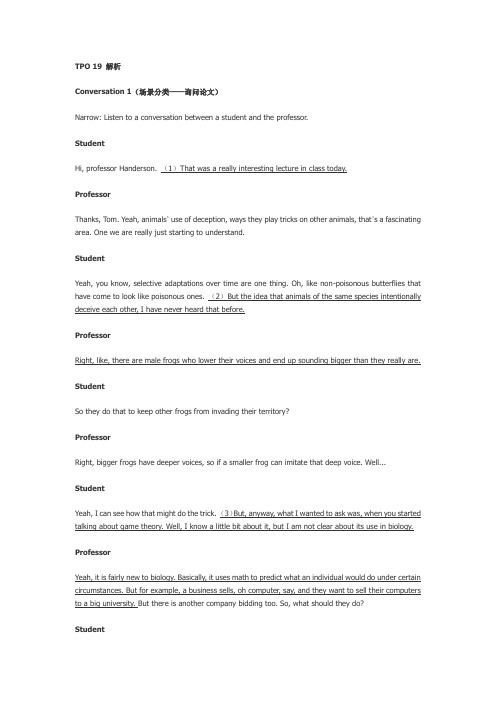
TPO 19 解析Conversation 1(场景分类——询问论文)Narrow: Listen to a conversation between a student and the professor.StudentHi, professor Handerson. (1)That was a really interesting lecture in class today.ProfessorThanks, Tom. Yeah, animals’ use of deception, ways they play tricks on other animals, that’s a fascinating area. One we are really just starting to understand.StudentYeah, you know, selective adaptations over time are one thing. Oh, like non-poisonous butterflies that have come to look like poisonous ones. (2)But the idea that animals of the same species intentionally deceive each other, I have never heard that before.ProfessorRight, like, there are male frogs who lower their voices and end up sounding bigger than they really are.StudentSo they do that to keep other frogs from invading their territory?ProfessorRight, bigger frogs have deeper voices, so if a smaller frog can imitate that deep voice. Well...StudentYeah, I can see how that might do the trick. (3)But, anyway, what I wanted to ask was, when you started talking about game theory. Well, I know a little bit about it, but I am not clear about its use in biology.ProfessorYeah, it is fairly new to biology. Basically, it uses math to predict what an individual would do under certain circumstances. But for example, a business sells, oh computer, say, and they want to sell their computers to a big university. But there is another company bidding too. So, what should they do?StudentWell, try to offer the lowest price so they can compete, but still make money.ProfessorRight, they are competing, like a game, like the frogs. There are risks with pricing too high, the company might get the sale, there is also the number and type of computers to consider. Each company has to find a balance between the cost and benefits. Well, game theory creates mathematical models that analyze different conditions like this to predict outcomes.StudentOk, I get that. But how does it apply to animals?Professor(4)Well, you know, if you are interested in this topic, it would be perfect for your term paper. StudentThe literature review?ProfessorYeah, find three journal articles about this or another topic that interests you and discuss them. If there is a conflict in the conclusions or something, that would be important to discuss.Student(5)Well, from what I have looked at dealing with game theory, I can’t say I understand much of the statistics end.ProfessorWell, I can point you to some that presents fairly basic studies, that don’t assume much background knowledge. You’ll just need to answer a few specific questions: What was the researchers’ hypothesis? What did they want to find out? And how did they conduct their research? And then the conclusions they came to. Learning to interpret these statistics will come later.词汇:deception n. 欺骗selective adj. 选择性的deceive v. 欺骗invade v. 侵略territory n. 领土imitate v. 模仿bid v. 投标;出价hypothesis n. 假设题目:1. Why does the man go to see the professor?解析:主旨题,文中学生开头说教授今天课上的演讲很有趣,接着讨论了课上的内容。
托福阅读TPO19答案解析
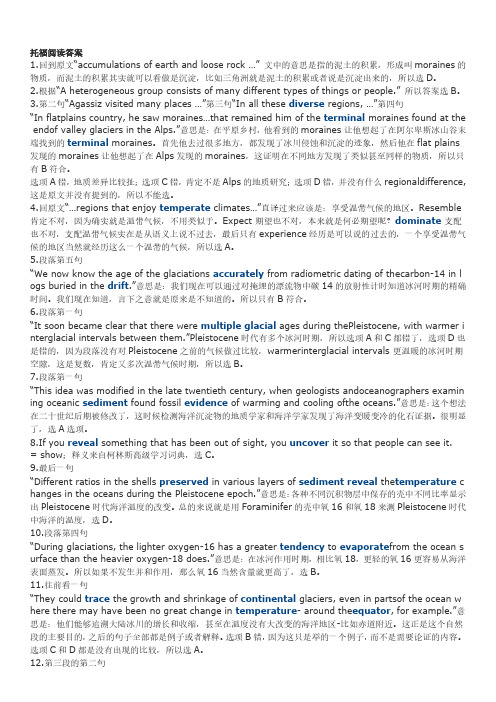
托福阅读答案1.回到原文“accumulations of earth and loose rock …” 文中的意思是指的泥土的积累,形成叫moraines的物质,而泥土的积累其实就可以看做是沉淀,比如三角洲就是泥土的积累或者说是沉淀出来的,所以选D。
2.根据“A heterogeneous group consists of many different types of things or people.” 所以答案选B。
3.第二句“Agassiz visited many places …”第三句“In all these diverse regions, …”第四句“In flatplains country, he saw moraines…that remained him of the terminal moraines found at the endof valley glaciers in the Alps.”意思是:在平原乡村,他看到的moraines让他想起了在阿尔卑斯冰山谷末端找到的terminal moraines。
首先他去过很多地方,都发现了冰川侵蚀和沉淀的迹象,然后他在flat plains 发现的moraines让他想起了在Alps发现的moraines,这证明在不同地方发现了类似甚至同样的物质,所以只有B符合。
选项A错,地质差异比较扯;选项C错,肯定不是Alps的地质研究;选项D错,并没有什么regionaldifference,这是原文并没有提到的,所以不能选。
4.回原文“…regions that enjoy temperate climates…”直译过来应该是:享受温带气候的地区。
Resemble 肯定不对,因为确实就是温带气候,不用类似于。
Expect 期望也不对,本来就是何必期望呢?dominate支配也不对,支配温带气候实在是从语义上说不过去,最后只有experience经历是可以说的过去的,一个享受温带气候的地区当然就经历这么一个温带的气候,所以选A。
tpo综合写作题目难度排序
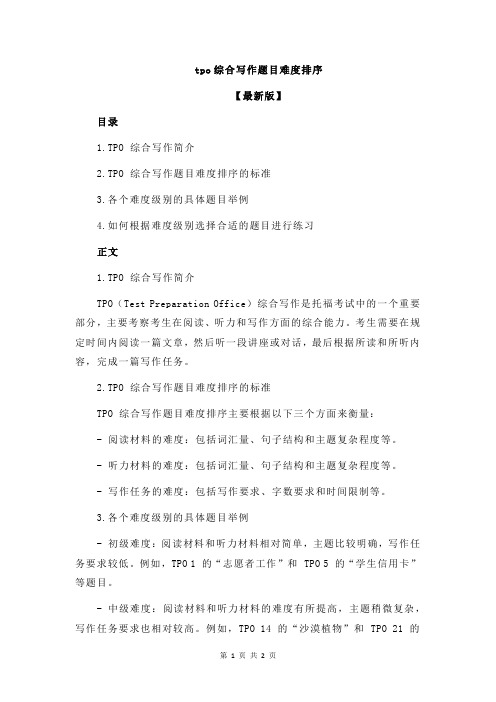
tpo综合写作题目难度排序【最新版】目录1.TPO 综合写作简介2.TPO 综合写作题目难度排序的标准3.各个难度级别的具体题目举例4.如何根据难度级别选择合适的题目进行练习正文1.TPO 综合写作简介TPO(Test Preparation Office)综合写作是托福考试中的一个重要部分,主要考察考生在阅读、听力和写作方面的综合能力。
考生需要在规定时间内阅读一篇文章,然后听一段讲座或对话,最后根据所读和所听内容,完成一篇写作任务。
2.TPO 综合写作题目难度排序的标准TPO 综合写作题目难度排序主要根据以下三个方面来衡量:- 阅读材料的难度:包括词汇量、句子结构和主题复杂程度等。
- 听力材料的难度:包括词汇量、句子结构和主题复杂程度等。
- 写作任务的难度:包括写作要求、字数要求和时间限制等。
3.各个难度级别的具体题目举例- 初级难度:阅读材料和听力材料相对简单,主题比较明确,写作任务要求较低。
例如,TPO 1 的“志愿者工作”和 TPO 5 的“学生信用卡”等题目。
- 中级难度:阅读材料和听力材料的难度有所提高,主题稍微复杂,写作任务要求也相对较高。
例如,TPO 14 的“沙漠植物”和 TPO 21 的“环境保护”等题目。
- 高级难度:阅读材料和听力材料的难度较大,主题非常复杂,写作任务要求也较高。
例如,TPO 27 的“生物多样性”和 TPO 30 的“能源危机”等题目。
4.如何根据难度级别选择合适的题目进行练习考生可以根据自己的实际水平和考试需求,选择不同难度级别的题目进行练习。
以下是一些建议:- 初级难度:适合托福考试新手或需要提高基本写作能力的考生。
- 中级难度:适合已经掌握基本写作技巧,需要提高综合写作能力的考生。
- 高级难度:适合需要挑战高难度题目,提高写作速度和质量的考生。
总之,TPO 综合写作题目难度排序有助于考生更好地选择适合自己的练习题目,提高托福考试成绩。
托福阅读TPO19(试题+答案+...

托福阅读TPO19(试题+答案+译文)第1篇:TheRomanArmy'sImpactonBritain托福TPO是托福备考小伙伴们最重要的参考资料,并且这个是在备考时候一定要认真多多练习,托福TPO是非常重要的希望大家一定要重视起来,小编为广大的托福考生整理了托福阅读TPO19(试题+答案+译文)第1篇:The Roman Army's Impact on Britain,下面就来跟小编一起来看下面精彩内容吧!托福阅读原文【1】In the wake of the Roman Empire's conquest of Britain in the first century A.D., a large number of troops stayed in the new province, and these troops had a considerable impact on Britain with their camps, fortifications, and participation in the local economy. Assessing the impact of the army on the civilian population starts from the realization that the soldiers were always unevenly distributed across the country. Areas rapidly incorporated into the empire were not long affected by the military. Where the army remained stationed, its presence was much more influential. The imposition of a military base involved the requisition of native lands for both the fort and the territory needed to feed and exercise the soldiers' animals. The imposition of military rule also robbed local leaders of opportunities to participate in local government, so social development was stunted and the seeds of disaffection sown. This then meant that the military had to remain to suppress rebellion and organize government.【2】 Economic exchange was clearly very important as the Roman army brought with it very substantial spending power. Locally a fort had two kinds of impact. Its large population needed food and other supplies. Some of these were certainlybrought from long distances, but demands were inevitably placed on the local area. Although goods could be requisitioned, they were usually paid for, and this probably stimulated changes in the local economy. When not campaigning, soldiers needed to be occupied; otherwise they represented a potentially dangerous source of friction and disloyalty. Hence a writing tablet dated 25 April tells of 343 men at one fort engaged on tasks like shoemaking, building a bathhouse, operating kilns, digging clay, and working lead. Such activities had a major effect on the local area, in particular with the construction of infrastructure such as roads, which improved access to remote areas.【3】 Each soldier received his pay, but in regions without a developed economy there was initially little on which it could be spent. The pool of excess cash rapidly stimulated a thriving economy outside fort gates. Some of the demand for the services and goods was no doubt fulfilled by people drawn from far afield, but some local people certainly became entwined in this new economy. There was informal marriage with soldiers, who until AD 197 were not legally entitled to wed, and whole new communities grew up near the forts. These settlements acted like small towns, becoming centers for the artisan and trading populations.【4】The army also provided a mean of personal advancement for auxiliary soldiers recruited from the native peoples, as a man obtained hereditary Roman citizenship on retirement after service in an auxiliary regiment. Such units recruited on an ad hoc (as needed) basis from the area in which they were stationed, and there was evidently large-scale recruitment within Britain. The total numbers were at least 12,500 men up to the reign of the emperor Hadrian (A.D. 117-138), witha peak around A.D. 80. Although a small proportion of the total population, this perhaps had a massive local impact when a large proportion of the young men were removed from an area. Newly raised regiments were normally transferred to another province from whence it was unlikely that individual recruits would ever return. Most units raised in Britain went elsewhere on the European continent, although one is recorded in Morocco. The reverse process brought young men to Britain, where many continued to live after their 20 to 25 years of service, and this added to the cosmopolitan Roman character of the frontier population. By the later Roman period, frontier garrisons (groups of soldiers) were only rarely transferred, service in units became effectively hereditary, and forts were no longer populated or maintained at full strength.【5】 This process of settling in as a community over several generations, combined with local recruitment, presumably accounts for the apparent stability of the British northern frontier in the later Roman period. It also explains why some of the forts continued in occupation long after Rome ceased to have any formal authority in Britain, at the beginning of the fifth century A.D. The circumstances that had allowed natives to become Romanized also led the self-sustaining military community of the frontier area to become effectively British.托福阅读试题1. Which of the sentences below best expresses the essential information in the highlighted sentence in paragraph 1? Incorrect choices change the meaning in important ways or leave out essential information.A.Many Roman soldiers remained in Britain after conquering it, and their presence had a strong influence.B.The new Roman province of Britain seemed to awaken in the first century A.D. as the local economy improved.C.Camps, fortifications, and economic change contributed to the Roman conquest of Britain.D.With the conquest of Britain by Roman troops, the Roman Empire gained considerable economic strength.2. According to paragraph 1, the Roman army had the most influence on those areas of Britain that wereA.conquered first.B.near population centers.ed as military bases.D.rapidly incorporated into the empire.3. According to paragraph 1, what effect did military occupation have on the local population?A.It encouraged more even distribution of the population and the settlement of previously undeveloped territory.B.It created discontent and made continuing military occupation necessary.C.It required local labor to construct forts and feed and exercise the soldiers’ animals.D.It provided local leaders with opportunities to participate in governance.4. The word “suppress” in the passage (paragraph 1) is closest in meaning toA.respond to.B.warn against.C.avoid the impact of.D.stop by force.5. The word “friction” in the passage (paragraph 2) is closest in meaning toA.rebellion.B.conflict.C.neglect.D.crime.6. The author mentions “343 men at one fort engaged on tasks like shoemaking, building a bathhouse, operating kilns, digging clay, and working lead”in paragraph 2 in order toA.describe the kinds of tasks soldiers were required to perform as punishment for disloyalty or misdeeds.B.illustrate some of the duties assigned to soldiers to keep them busy and well-behaved when not involved in military campaigns.C.provide evidence that Roman soldiers had a negative effect on the local area by performing jobs that had been performed by native workers.D.argue that the soldiers would have been better employed in the construction of infrastructure such as roads.7. The phrase “entitled to” in the passage (paragraph 3) is closest in meaning toA.given the right to.B.able to afford to.C.encouraged to.D.required to.8. According to paragraph 3, how did the soldiers meet their needs for goods and services?A.Their needs were met by the army, and all of their economic transactions took place within the fort.B.Most of their needs were met by traveling tradespeople who visit the forts.C.During their days off, soldiers traveled to distant towns tomake purchases.D.They bought what they needed from the artisans and traders in nearby towns.9. According to paragraph 4, which of the following is true of Britain’s auxiliary regiments of the Roman army?A.Membership in these regiments reached its highest point during the region of the emperor Hadrian.B.Most of the units recruited in Britain were sent to Morocco and other stations outside Europe.C.Soldiers served in the regiments for many years and after retirement generally stayed where they had been stationed.D.Most of the regiments stationed on the frontier were new units transferred from a neighboring province.10. According to paragraph 4, all of the following changes could be seen in the frontier garrisons by the later Roman period EXCEPT:A.Membership in the units passed from father to son.B.Fewer soldiers were stationed at the forts.C.Soldiers usually were not transferred to different locations.D.Frontier units became more effective and proficient.11. Why does the author mention that “some of the forts continued in occupation long after Rome ceased to have any formal authority in Britain”in paragraph 5 ?A.To emphasize the degree to which the stability of the British northern frontier depended on firm military control.B.To suggest that the Romans continued to occupy Britain even after they had formally given up the right to do so.C.To support the claim that forts continued to serve an import economic function even after they ceased to be of any military use.D.To describe one of the things that resulted from frontier garrisons’ becoming part of the local community over a long period.12. The word “circumstances” in the passage (paragraph 5) is closest in meaning toA.experiences.munities.C.conditions.ws.13. Look at the four squares [■] that indicate where the following sentence could be added to the passage. Where would the sentence best fit? One solution was to keep them busy as sources of labor.Paragraph 2: Economic exchange was clearly very important as the Roman army brought with it very substantial spending power. Locally a fort had two kinds of impact. Its large population needed food and other supplies. ■【A】Some of these were certainly brought from long distances, but demands were inevitably pla ced on the local area. ■【B】 Although goods could be requisitioned, they were usually paid for, and this probably stimulated changes in the local economy. ■【C】When not campaigning, soldiers needed to be occupied; otherwise they represented a potentially dangerous source of friction and disloyalty. ■【D】 Hence a writing tablet dated 25 April tells of 343 men at one fort engaged on tasks like shoemaking, building a bathhouse, operating kilns, digging clay, and working lead. Such activities had a major effect on the local area, in particular with the construction of infrastructure such as roads, which improved access to remote areas.14. Directions: An introductory sentence for a brief summaryof the passage is provided below. Complete the summary by selecting the THREE answer choices that express the most important ideas in the passage. Some sentence do not belong to the summary because they express ideas that are no presented in the passage or are minor ideas in the passage. This question is worth 2 points.Th e Roman army’s occupation of Britain influenced and changed the local population.A.Although the presence of the army in certain areas caused resentment among the local population, it provided important services such as building infrastructure.B.By recruiting unemployed young men for its auxiliary units, the army made it possible for them to stay in their home towns and provide financial support for their families.rge quantities of cash from soldiers’ pay stimulated development, but also drove up prices, making it hard for local residents to afford goods and services.D.Though the army appropriated land and some goods, it also paid for many supplies, stimulating local economic growth.E.The forts contributed to the quality of local crafts by bringing in artisans from distant places who brought with them new skills and techniques.F.Roman soldiers started families with local inhabitants, and over the generations, the military community became a stable part of British society.托福阅读答案1.原文in的部分是非主要成分,结构是军队呆在blabla,并且有影响,所以答案是A。
托福TPO的难度差别怎么那么大?

托福TPO的难度差别怎么那么大?
TPO是真题,里面所有的题都来自ETS官方题库,自然有难题有简单的题,lz如果考过托福应该有感觉,托福考试阅读部分的三篇文章难度也是不一样的。
比如我最近这次托福,第一篇阅读明显要比第二三篇难很多,你不能指望所有题难度都一样,要学着去适应,不过真正考试时不会所有题都那么难就是了。
听力也是一样的,有难有易,托福官方题库有不少题都是从SAT那里买来的,SAT阅读比托福要难,所以做起来肯定感觉吃力,这很正常。
托福OG其实我从来不建议做,太简单了,小儿科的东西,Delta都比OG难,那本书就是浪费时间和金钱的产物,lz不要碰了。
TPO的难度和真正考试难度最接近,建议你主攻这个,巴朗啊什么的就别碰了,出题路子跟真题相差甚远,做了反而影响考试发挥。
呵呵,lz这是第一次啊,不用紧张,正常发挥就好,TPO你都做完都弄懂90+肯定没问题,相信自己,祝你成功!
1。
史上最全托福TPO1-31阅读 题材结构科目分类

史上最全托福TPO1-31阅读题材结构科目分类自然科学一、地质学冰川类1 OG:Green Icebergs2 TPO 15:Glacier Formation3 TPO 19:Discovering The Ice Ages地质现象1 OG:Geology and Landscape2 TPO 01:Groundwater3 TPO 02:Desert Formation4 TPO 03:Depletion of The Ogallala Aquifer5 TPO 07:The Geologic History of The Mediterranean6 TPO 12:Water in The Desert7 TPO 20:Fossil Preservation8 TPO 21:Geothermal Energy9 TPO 24:Lake Water10 TPO 28-1:Groundwater11 TPO 27-2:The Formation of Volcanic Islands二、天文学火星类1 TPO 08:Running Water On Mars2 TPO 25:The Surface of Mars其他行星类1 TPO 16:Planets in Our Solar System2 TPO 22:The Allende Meteorite生物科学一、植物学1 Sample:Opportunity and Competitors2 TPO 01:Timberline Vegetation on Mountains3 TPO 05:Minerals and Plants4 TPO 09:The Arrival of Plant Life in Hawaii5 TPO 22:Spartina6 TPO 25:The Evolutionary Origin of Plants二、动物学动物特点1 OG:Swimming Machines2 OG:Feeding Habits of East African Herbivores3 TPO 04:Deer Population of The Puget Sound4 TPO 13:Biological Clock5 TPO 15:A Warm-blooded Turtle6 TPO 17-3:Symbiotic Relationship动物变化1 Sample:Meteorite Impact and Dinosaur Extinction2 TPO 05:The Cambrian Explosion3 TPO 08:Extinction of The Dinosaurs4 TPO 15:Mass Extinctions5 TPO 31-1: Speciation in Geographically Isolated Populations6 TPO 30-2: The Pace of Evolutionary Change动物行为1 TPO 02:The Origins of Cetaceans2 TPO 11:Begging by Nestlings3 TPO 11:Orientation and Navigation4 TPO 17:Ani mal Signals in The Rain Forest5 TPO 30-1 Role of Play in Development6 TPO 29-2:Competition7 TPO 28-3:Buck Rubs and Buck Scrapes8 TPO 27-3:Predator-Prey Cycles三、生态/环境/能源1 TPO 03:The Long-Term Stability of Ecosystems2 TPO 19:Succession, Climax, and Ecosystems3 TPO 26:Survival of Plants and Animals in Desert Conditions4 TPO 31-3: Savanna Formation1 Sample:Electricity from Wind2 TPO 04:Petroleum Resources3 TPO 29-3:The History of Waterpower3 TPO 10:Variations in The Climate4 TPO 18:Lightning5 TPO 23:Urban Climates社会科学一、艺术绘画/雕塑/陶瓷1 Sample:Lascaux Cave Paintings2 TPO 04:Cave Art in Europe3 TPO 10:Chinese Pottery4 TPO 11:Ancient Egyptian Sculpture5 TPO 23:Rock Art of the Australian Aborigines6 TPO 29-1:Characteristics of Roman Pottery7 TPO27-1:Crafts in the Ancient near East建筑/戏剧/电影/摄影1 OG:Applied Arts and Fine Arts2 TPO 01:The Origins of Theater3 TPO 02:Early Cinema4 TPO 03:Architecture5 TPO 12:Transition to Sound in Film10 TPO 22:The Birth of Photography二、历史/考古学工业化介绍1 OG:Artisans and Industrialization2 TPO 06:Powering The Industrial Revolution3 TPO 18:Industrialization in The Netherlands and Scandinavia4 TPO 26:Energy and the Industrial Revolution5 TPO 30-3: The Invention of the Mechanical Clock贸易/经济介绍1 TPO 10:Seventeenth-Century European Economic Growth2 TPO14:Pastoralism in Ancient Inner Eurasia3 TPO 16:Trade and The Ancient Middle East4 TPO 17:Europe’s Early Sea Trade with Asia5 TPO 25:The Decline of Venetian Shipping农业发展介绍 1 TPO 07:Agriculture, Iron, and The Bantu Peoples2 TPO21:The Origins of Agriculture3 TPO 23:Seventeenth-Century Dutch Agriculture国家/城市特点1 OG:Nineteenth-Century Politics in The United States2 TPO 07-2:Ancient Rome and Greece3 TPO 08:The Rise of Teotihuacan4 TPO 14:Maya Water Problems5 TPO 19:The Roman Army’s Impact on Britain6 TPO 26:Sumer and The First Cities of The Ancient Near East 人口变化特点1 TPO 05:The Origins of The Pacific Island People2 TPO 09:Colonizing The Americas Via The Northwest Coast3 TPO 20:Westward Migration4 TPO 20:Early Settlement in The Southwest Asia5 TPO 24:Moving into Pueblos6 TPO 28-2: Early Saharan Pastoralists三、心理/生理学1 OG:Aggression2 OG:The Expression of Emotion3 TPO06:Infantile Amnesia4 TPO 13:Methods of Studying Infant Perception5 TPO 18:The Mystery of Yawning6 TPO 21:Autobiographical Memory7 TPO 24:Breathing During Sleep四、社会学1 TPO09:Reflection in Teaching2 TPO 13:Types of Social Groups3 TPO 14:Childrenand Advertising4 TPO 31-2: Early Children Education其他学科类1 OG:Loie Fuller2 TPO 06:William Smith3 TPO 16:Development of The Periodic Table4 TPO 12:Which Hand Did They Use?结构体裁难度系数现象到解释:形成过程Exposition 现象到解释:形成过程Exposition现象到解释:形成过程:对比Exposition现象到解释Exposition现象到解释:原因:分类Exposition现象到解释Exposition现象到解释:形成过程Historical现象到解释:分类Exposition现象到解释Exposition现象到解释Exposition5现象到解释:对比Exposition 现象到解释:对比Exposition现象到解释Exposition现象到解释:总分Historical现象到解释Exposition现象到解释Exposition现象描述:分类Exposition现象到解释:分类Exposition现象到解释(含研究)理论解释(新旧对比)现象到解释(含研究)Exposition现象描述:分类Exposition现象到解释(含研究)Exposition现象到解释(含研究)Exposition现象到解释(含研究)Exposition现象到解释(含研究)Exposition现象到解释Exposition现象到解释总分:分类起源及发展Historical起源及发展Historical现象到解释:形成过程Exposition现象到解释总分:分类Historical HistoricalHistoricalHistoricalHistorical 现象到解释Historical 现象到解释Historical现象描述:分类Exposition起源及发展Historicalcandinavia起源及发展Historical现象到解释:总分Historical现象到解释:总分HistoricalHistorical 现象到解释:总分:Classificatio现象到解释: Classification Historical 现象到解释:总分Historical Exposition 现象到解释:总分:Classificatio现象到解释(含研究)Exposition 现象到解释(含研究)。
托福真题听力OG,TPO1-19全题目分析Part1

admit students to graduate school?
究领域。
O They often lack expertise in the fields of the
B. 迷惑选项。原文意思是老师不会要求格式,但是
applicants.
看材料的时候同时也会看。并不是说老师不会看目 Also, think about
B
议。
at my grad school application . . .
C. 迷惑选项。学生在对话开始前已经把申请表交给 you know, the statement of purpose I
老师。
wrote.
D. 迷惑选项。学生还没有交申请,不涉及到是否被
录取。
A. 正确选项。直接对应。老师建议学生将不同要点 A. but it’s critical that . . . that
分段写,其中就包括学生的motivation
somebody sees what your passion
AC
B. 迷惑选项。Medicine是教授举的例子中的信息, is—your personal motivation for
与学生无关。 C. 正确选项。直接对应。老师建议学生在申请中充
doing
4. Why does the professor tell a story about his friend
who went to medical school?
O To warn the student about how difficult graduate
OG 1
1
4
school can be O To illustrate a point he is making
托福tpo听力最难的几篇

托福tpo听力最难的几篇托福考试是国际英语能力测试系统,它的听力部分被认为是考生最具挑战性的一部分。
尤其是TPo(TOEFL Practice Online)的听力部分,被很多考生视为其中最难的一部分。
本文将从几个不同的角度来分析TPo听力中的一些难点,以帮助考生更好地应对这一部分的挑战。
一、语速快、词汇量大TPo听力中最令考生头疼的一点是语速快、词汇量大。
在听力材料中,很多教授和学生会急匆匆地讲述不同的话题,同时使用许多高级词汇和专业术语。
这对考生的听力速度和词汇量都提出了很高的要求。
面对这种情况,考生可以通过以下方法来提高应对能力:首先,平时要多听英语材料,特别是一些较快的英语播客或录音,以适应快速语速。
其次,注重积累词汇,特别是和学术领域相关的词汇。
背单词和阅读一些学术文章可以很好地提高词汇量。
二、听力材料种类多样TPo听力材料涵盖了很多不同种类的内容,如学术讲座、学生讨论、课堂讲解等等。
对于不同种类的听力材料,考生需要有灵活的应对策略。
对于学术讲座,考生可以先浏览提纲,对即将听到的内容有一个大致的了解。
对于学生讨论和课堂讲解,考生可以通过注意听讲者的观点和逻辑关系来抓住重点。
三、听力材料难度递增TPo中的听力材料的难度是递增的,从易到难。
对于初学者来说,可能面对一些较简单的材料就感到困难重重。
因此,为了更好地应对TPo听力,考生需要加强听力训练,逐渐适应并提高自己的听力水平。
在平时的学习中,考生可以通过听一些容易的英语材料,如儿童故事、英语歌曲等,提高自己的听力。
四、听力技巧的运用在TPo听力考试中,考生需要有一些听力技巧的运用,以更好地理解听力材料。
首先,要注意利用上下文信息。
通常,听力材料中的信息是相互关联的,通过抓住上下文中的线索,可以更好地理解听力材料。
其次,要注意听力材料中的转折词和信号词。
转折词和信号词可以帮助我们捕捉重点信息和主旨。
最后,要注意听力材料中的态度和观点。
学习者可以通过注意讲者的语气和词语选择,来判断讲者的态度和观点。
TPO-19 Reading 3解析
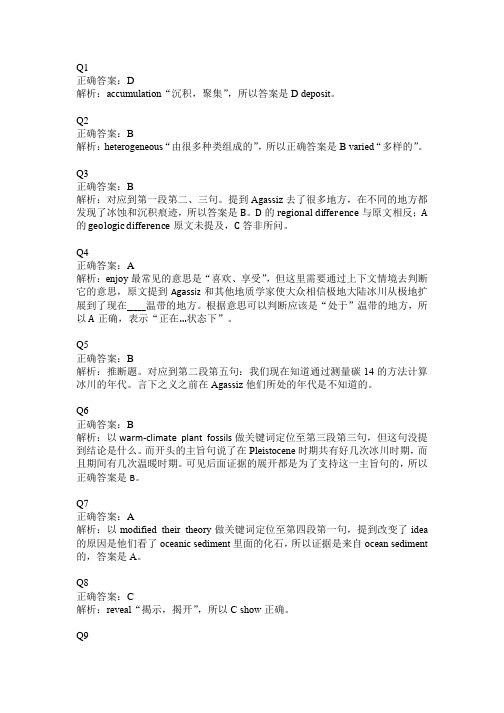
Q1正确答案:D解析:accumulation“沉积,聚集”,所以答案是D deposit。
Q2正确答案:B解析:heterogeneous“由很多种类组成的”,所以正确答案是B varied“多样的”。
Q3正确答案:B解析:对应到第一段第二、三句。
提到Agassiz去了很多地方,在不同的地方都发现了冰蚀和沉积痕迹,所以答案是B。
D的regional difference与原文相反;A 的geologic difference原文未提及,C答非所问。
Q4正确答案:A解析:enjoy最常见的意思是“喜欢、享受”,但这里需要通过上下文情境去判断它的意思,原文提到Agassiz和其他地质学家使大众相信极地大陆冰川从极地扩展到了现在_____温带的地方。
根据意思可以判断应该是“处于”温带的地方,所以A正确,表示“正在…状态下”。
Q5正确答案:B解析:推断题。
对应到第二段第五句:我们现在知道通过测量碳14的方法计算冰川的年代。
言下之义之前在Agassiz他们所处的年代是不知道的。
Q6正确答案:B解析:以warm-climate plant fossils做关键词定位至第三段第三句,但这句没提到结论是什么。
而开头的主旨句说了在Pleistocene时期共有好几次冰川时期,而且期间有几次温暖时期。
可见后面证据的展开都是为了支持这一主旨句的,所以正确答案是B。
Q7正确答案:A解析:以modified their theory做关键词定位至第四段第一句,提到改变了idea 的原因是他们看了oceanic sediment里面的化石,所以证据是来自ocean sediment 的,答案是A。
Q8正确答案:C解析:reveal“揭示,揭开”,所以C show正确。
Q9正确答案:D解析:根据关键词foraminifera shells定位到第四段后三句,说到这个壳是什么,另外壳的普通氧(氧16)和重氧同位素(氧18)的比例不同,比例取决于生物居住的水域的温度,这种比例差异能反映出海洋气温变化。
TPO1--19听力答案

IBT-SAT 小马过河—专业备考社区
12. B 13. 14. 15. 16. 17. ABE A A B B 15. AB 16. C 17. A 15. C 16. AB 17. B 15. AC 16. D 17. B 15.C 16.D 17.B
小马过河 ——专业备考社区 小马过河 X aoma com——专业备考社区
8. AC
8. A
8. A
8.D
8. A
8. A,D
9. C 10. A 11. BDE 12. D 13. C "
9. B 10. B 11. C,D 12. C 13. D
9. B 10. D 11. C 12. B 13. B,D
9.A 10.D 11.C 12.C 13.D
9. D 10. C 11. B 12. A 13. A,C,E
14. B,D
9. C 10. D 11. B 12. A 13. 1. Pressure … 2. A liquid…
13 A
15. A
15. B
14 A,D
16. A
16. A
15 C
17. B
17. C
16 D
16.Folk tales: B,C Fairy tales: A,D,E,F 17.A
3. C
3. A
3. A,D
3.B
3.D
3. A,C
4. 5. 6. 7.
A B C C
4. 5. 6. 7.
D D C B
8. A 9. B 10. B 11. A 12. B 13. D 14. The amount of…… The age of…… Zircon in the……. " 15. B 16. A 17. B Section 2 1. B 2. A 3. D 4. BDE
TPO听力难度表
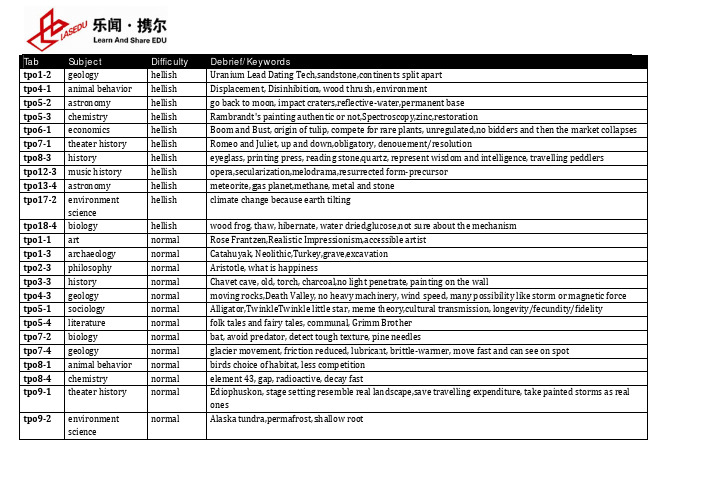
Tabtpo1‐2tpo4‐1tpo5‐2tpo5‐3tpo6‐1tpo7‐1tpo8‐3tpo12‐3tpo13‐4tpo17‐2tpo18‐4tpo1‐1tpo1‐3tpo2‐3tpo3‐3tpo4‐3tpo5‐1tpo5‐4tpo7‐2tpo7‐4tpo8‐1tpo8‐4tpo9‐1tpo9‐2 Subject geology animal behavio astronomy chemistry economics theater history history music history astronomy environment science biology art archaeology philosophy history geology sociology literature biology geology animal behavio chemistry theater history environmentscience Difficulty hellish or hellish hellish hellish hellish y hellish hellish hellish hellish hellish hellish normal normal normal normal normal normal normal normal normal or normal normal y normal normal Debrief/Ke Uranium Le Displaceme go back to m Rambrandt Boom and B Romeo and eyeglass, pr opera,secul meteorite, g climate cha wood frog, Rose Frantz Catahuyak,Aristotle, w Chavet cave moving roc Alligator,Tw folk tales an bat, avoid p glacier mov birds choic element 43Ediophusko ones Alaska tund eywords ead Dating Tech,ent, Disinhibition moon, impact cra t's painting authe Bust, origin of tu d Juliet, up and do rinting press, rea larization,melod gas planet,metha ange because ear thaw, hibernate,zen,Realistic Imp Neolithic,Turkey what is happiness e, old, torch, char cks,Death Valley, winkleTwinkle li nd fairy tales, com predator, detect t vement, friction r e of habitat, less 3, gap, radioactive on, stage setting dra,permafrost, s sandstone,contin n, wood thrush, e aters,reflective‐w entic or not,Spec lip, compete for own,obligatory, d ading stone,quart rama,resurrecte ane, metal and st rth tilting , water dried,glu pressionism,acce y,grave,excavatio s rcoal,no light pen no heavy machin ittle star, meme t mmunal, Grimm tough texture, pi reduced, lubrican competition e, decay fast resemble real la shallow rootnents split apart environment water,permanent troscopy,zinc,res rare plants, unre denouement/res tz, represent wis d form‐precurso tone cose,not sure abo essible artist on netrate, painting nery, wind speed theory,cultural tr Brother ne needles nt, brittle‐warme ndscape,save tra t base storation egulated,no bidde olution sdom and intellig r out the mechanis on the wall d, many possibilit ransmission, long er, move fast and avelling expendit ers and then the gence, travelling p sm ty like storm or m gevity/fecundity d can see on spot ture, take painted market collapses peddlers magnetic force y/fidelity d storms as real sTabtpo9‐3tpo9‐4tpo10‐1tpo10‐2tpo10‐4tpo11‐1tpo11‐3tpo12‐1tpo12‐4tpo14‐2tpo14‐3tpo14‐4tpo16‐1tpo16‐2tpo16‐3tpo16‐4tpo17‐1tpo17‐3tpo17‐4tpo18‐1tpo18‐2tpo18‐3tpo19‐3tpo19‐4tpo1‐4 Subject geology linguistic marine biology european histo psychology biology environment science biology environment science biology astronomy archaeology geology music history biology art history art history history biology astronomy art history european histo marine biology portrait biology Difficulty normal normal y normal ory normal normal normal normal normal normal normal normal normal normal normal normal normal normal normal normal normal normal ory normal y normal normal easy Debrief/Ke Empty Qua only human whales evlo potato tom eary memo birds' paren wetland tur skin cell,ne how do we microclima navigation,passage gra limestone c piano, harp beaver,dist stain glass,c limitations Nile River,c animal defe sun spots, G Roman cop significance Spartina,os painter's ow Eastern and eywords arter, limestone, t n have language,oved from land a ato transfer from ory of babies, Piag nting, distraction rned into dry far erve cell,junk DNA tap solar energy ate,squirrel tropic,polynesia aves, astronomic cave, sulfuric acid psichord,percussi tant log or nearby church,paint on g of dating techs,la calender ense mechanism,Galileo,cloud hyp py ancient Greek'e of spice,Roman smosis,form colon wn interpretatio d Olympic Marm two periods, rece coyote,discreten animals, hippo, pa m Mexico to Euro get's theory, 9 m n display, fake as rmland in Florida A,chromosome, t y, gather and stor n,stone canoe, st cal calendar, echo d, carbonic acid,b ion,upper class,w y log,save energy glass ady with a hood,, Octpus,relaxed pothesis,magneti s statues,Roman n empire collapse ny to withstand s n mot,aggressive,fam ent lakes and anc ness, productive akistan fossils ope, power center months baby has m wounded,protec a,climate change,telemere, protect re,power plant, o tar pair o,standing wave,r bacteria eat oil, w women learn to p y or evade predat strata,carbon da or contracted sa c,40 years observ admire Greek,co e‐trade indirect,e storm mily orientedcient lakes,sandd r shift from south memory ct youth El Nino tive shoelace only time will tell resonance wear mask becau play tor ating,genre cks,ink cloud vation oins stamped wit expensive,spoiled dunes, particles fo h to north l use of smell th emperor's icon d meat orm pan nTabtpo2‐1tpo2‐2tpo3‐1tpo3‐2tpo3‐4tpo4‐2tpo4‐4tpo6‐2tpo6‐3tpo6‐4tpo7‐3tpo8‐2tpo10‐3tpo11‐2tpo13‐1tpo13‐2tpo13‐3tpo14‐1tpo19‐1tpo19‐2tpo11‐4tpo12‐2tpo2‐4 Subject psychology botany environment science film history astronomy literature US government biology creative writing earth science anthropology art history ecology architecture city planning ecology poetry psychology linguistic astronomy business business astronomy Difficulty easy easy easy easy easy easy t easy easy g easy easy easy easy easy easy easy easy easy easy easy easy Extremely Extremely abnormal Debrief/Ke Larynx,mus Manila Hem humming b Paneleve an Spectrosco Waldo Eme governmen nightcap oa personality Sahara dese Native Ame Baershkcai P and Nitro functional a pedestrian beaver, key chanson an cognition family tree,radio telesc y easy y easy How to mea eywords scular movemen mp,strong,resiste bird, energy effici nd Jean Cousteau py, figure out ele erson, non‐confo nt support of arts ak in Australia, li y, highway, ert before parad erican, Indians,bi f, Paris art schoo ogen cycle, land p architecture, no d mall, location an ystone species,sti nd adventure, tra , borrow,too sim cope,invisible lig asure distance b t,throat and hand ent to water,twist ient,loss of habit u, underwater sh ements on certain rmity, inconsiste s,Lincoln and Ken ving fossil,sprea ise, Monsoon‐sea irch tree made in ol only for woman phase, ocean pha decoration nd design, Kentuc ill water and flow abadour, knight, l ple ght,light pollution etween asteroids d movement, Ide t into bundle at,banded and tr hooting, unqiue st n planet,prism,fla ency,career choic nnedy Center,hel d, seed locked in asonal wind, eart nto canoes, water n, Paris is the pla se, atomosphere cky Louisville,wh wing water,build luxury of time n s, Bode Laweomotor rack tyle, male seahor ame test ce lp artists find job n shell,germinate th tilt and motion rproof,utensil,tra ace to go e hat missing? dam rse keep babies bs, not waste of m n, ade,French adpot money t design。
托福听力TPO难度划分分析
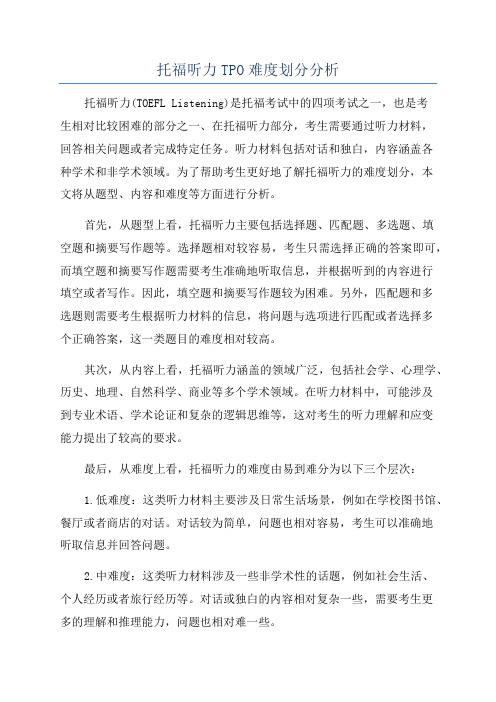
托福听力TPO难度划分分析托福听力(TOEFL Listening)是托福考试中的四项考试之一,也是考生相对比较困难的部分之一、在托福听力部分,考生需要通过听力材料,回答相关问题或者完成特定任务。
听力材料包括对话和独白,内容涵盖各种学术和非学术领域。
为了帮助考生更好地了解托福听力的难度划分,本文将从题型、内容和难度等方面进行分析。
首先,从题型上看,托福听力主要包括选择题、匹配题、多选题、填空题和摘要写作题等。
选择题相对较容易,考生只需选择正确的答案即可,而填空题和摘要写作题需要考生准确地听取信息,并根据听到的内容进行填空或者写作。
因此,填空题和摘要写作题较为困难。
另外,匹配题和多选题则需要考生根据听力材料的信息,将问题与选项进行匹配或者选择多个正确答案,这一类题目的难度相对较高。
其次,从内容上看,托福听力涵盖的领域广泛,包括社会学、心理学、历史、地理、自然科学、商业等多个学术领域。
在听力材料中,可能涉及到专业术语、学术论证和复杂的逻辑思维等,这对考生的听力理解和应变能力提出了较高的要求。
最后,从难度上看,托福听力的难度由易到难分为以下三个层次:1.低难度:这类听力材料主要涉及日常生活场景,例如在学校图书馆、餐厅或者商店的对话。
对话较为简单,问题也相对容易,考生可以准确地听取信息并回答问题。
2.中难度:这类听力材料涉及一些非学术性的话题,例如社会生活、个人经历或者旅行经历等。
对话或独白的内容相对复杂一些,需要考生更多的理解和推理能力,问题也相对难一些。
3.高难度:这类听力材料涉及学术性的话题,例如科学实验、历史事件、学术讲座等。
对话或独白的内容较为复杂,可能包含专业术语和复杂的逻辑推理,问题也更加困难。
这类听力材料对考生的听力理解能力和学科知识的掌握程度提出了更高的要求。
需要注意的是,托福考试的难度是相对的,不同考生对难度的感受也会有所不同。
但无论对于哪一类听力材料,考生都需要通过大量的练习来提高自己的听力能力,并逐步适应不同难度的听力材料。
新托福突破口TPO(1-30 纸质版)听力分类总结(用于横听及总结)
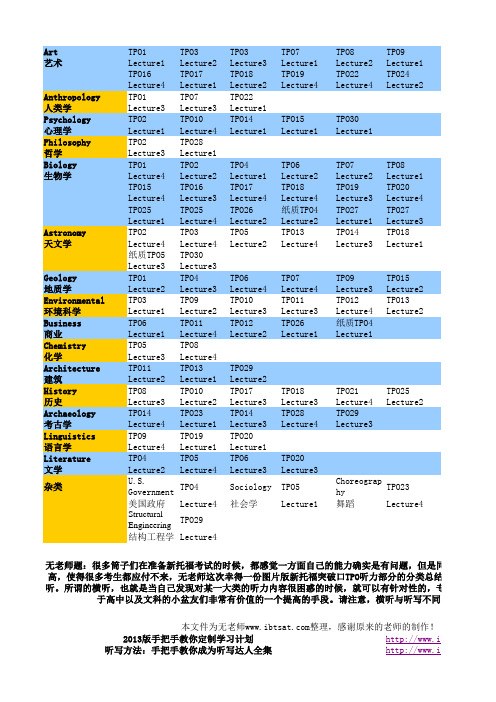
Art TPO1TPO3TPO3TPO7TPO8TPO9艺术Lecture1Lecture2Lecture3 Lecture1Lecture2Lecture1TPO16TPO17TPO18TPO19TPO22TPO24Lecture4Lecture1Lecture2Lecture4Lecture4Lecture2Anthropology TPO1TPO7TPO22人类学Lecture3Lecture3Lecture1Psychology TPO2TPO10TPO14TPO15TPO30心理学Lecture1Lecture4Lecture1Lecture1Lecture1Philosophy TPO2TPO28哲学Lecture3Lecture1Biology TPO1TPO2TPO4TPO6TPO7TPO8生物学Lecture4Lecture2Lecture1Lecture2Lecture2Lecture1TPO15TPO16TPO17TPO18TPO19TPO20Lecture4Lecture3Lecture4Lecture4Lecture3Lecture4TPO25TPO25TPO26纸质TPO4TPO27TPO27Lecture1Lecture4Lecture2Lecture2Lecture1Lecture3Astronomy TPO2TPO3TPO5TPO13TPO14TPO18天文学Lecture4Lecture4Lecture2Lecture4Lecture3Lecture1纸质TPO5TPO30Lecture3Lecture3Geology TPO1TPO4TPO6TPO7TPO9TPO15地质学Lecture2Lecture3Lecture4Lecture4Lecture3Lecture2Environmental TPO3TPO9TPO10TPO11TPO12TPO13环境科学Lecture1Lecture2Lecture3 Lecture3Lecture4Lecture2Business TPO6TPO11TPO12TPO26纸质TPO4商业Lecture1Lecture4Lecture2Lecture1Lecture1Chemistry TPO5TPO8化学Lecture3Lecture4Architecture TPO11TPO13TPO29建筑Lecture2Lecture1Lecture2History TPO8TPO10TPO17TPO18TPO21TPO25历史Lecture3Lecture2Lecture3 Lecture3 Lecture4Lecture2Archaeology TPO14TPO23TPO14TPO28TPO29考古学Lecture4Lecture1Lecture3 Lecture4Lecture3Linguistics TPO9TPO19TPO20语言学Lecture4Lecture1Lecture1Literature TPO4TPO5TPO6TPO20文学Lecture2Lecture4Lecture3 Lecture3杂类U.S. Governme TPO4Sociology TPO5Choreography T PO23美国政府Lecture4社会学Lecture1舞蹈Lecture4Structural Engine TPO29结构工程学Lecture4无老师题:很多筒子们在准备新托福考试的时候,都感觉一方面自己的能力确实是有问题,但是同太高,使得很多考生都应付不来,无老师这次幸得一份图片版新托福突破口TPO听力部分的分类总结,特地放出横听。
- 1、下载文档前请自行甄别文档内容的完整性,平台不提供额外的编辑、内容补充、找答案等附加服务。
- 2、"仅部分预览"的文档,不可在线预览部分如存在完整性等问题,可反馈申请退款(可完整预览的文档不适用该条件!)。
- 3、如文档侵犯您的权益,请联系客服反馈,我们会尽快为您处理(人工客服工作时间:9:00-18:30)。
Average
Average Average Average Easy Average/ Difficult
L6 Element periodic table (Chemistry) TPO 9 L1 L2 L3 L4 L5 L6 Career path & term paper topic Loutherbourg’s Theatric Invention Theater)
TPO 难度分析: 很实用的哦~
缩写:AC: academic conversation; L: lecture TPO 1 L1 L2 L3 L4 L5 L6 How to use library resources Realistic impressionism (Art: painting) Uranium- lead dating (Geology/ Chemistry) An observed class Mexican Neolithic site: (Archeology/ Anthropology) Çatalhöyük problem comparison (AC) process (Lecture) event description (L) cause & comparison (AC) event category (AC) cause & process (L) event happiness category (L) definition (AC) problem habitat cause & effect (L) comparison (AC) event description & cause (L) process (AC) & definition & history
Easy
Average Difficult Easy Easy Average Easy
TPO 13 2006 年 6 月 9 日
Easy
Average Average
Easy Average
TPO 14 L1 L2 L3 L4 L5 Finding a book/ reserve rule/ job apply Cognition process (psychology) Microclimate (biology) Reporting career plan Polynesian (astronomy) navigation
category (L) (AC) Problem definition & process (L) definition & comparison (AC) Problem cause & history (L) cause (AC) Problem process (L) cause (AC) Event category (L) cause (AC) Event listing & effect (AC) category & process (L)
Difficult
Easy Difficult Average
TPO 10 2008 年 6 月 7 日 L1 L2
Average problem listing (L)
Easy Difficult
how to get her photographs exhibited
Whale evolution (Biology)
L3 L4 L5 L6 L1 L2 L3 L4 L5 L6
American food spread to Europe (Biology/ history (AC) Government) problem Returning a book to bookshop Phosphorus circle (Chemistry/ process (AC) Environment) Child amnesia (Psychology) Gym pass & swimming class Distraction displays (Biology) Cape Cod House (Architecture) Job invitation Wetland changing (Climate) Key elements (Economics) of cause (L) problem & solution category (L) cause (AC) event effect (AC) advertisement category (L)
Average
Easy Average
Difficult
TPO 11
Easy
Average Easy Average Average Difficult Easy
TPO 12 L1 L2 L3 L4 L5 L6 L1 L2 L3 L4 L5 L6 Refine the paper Aging problem of human cell (Biology) MBWA (Economics) Delayed check Opera history (Art: Music) Solar energy development (Physics) Difficulty on understanding assignment Pedestrian mall (Economics) Interrelationship in Ecology (Biology/ Environment) Reserve a study in library Chanson vs. Romance (Literature) Types of meteoroids (Astronomy) system problem cause (L) category (AC) problem history (L) history & cause (AC) problem category & cause (L) causality (AC) problem comparison (AC) category & comparison (L) problem/ event category (L) cause & process (AC) event approach cause (location convenience) & definition listing problem to handle distraction cause & process (AC)
French underwater filmmaker (Art: film) Job application/ content How did we determine the oldest cave art (Art: painting) Spectroscopy (Astronomy/ Chemistry)
Easy Average Difficult (词 汇) Difficult (词 汇)
TPO 4 L1 L2 L3 L4 L5 library resources discussing Displacement activity (Biology) Emerson’s philosophy (Philosophy) Difficulties of a project Rock moving (Geology) event/ problem category & comparison (AC) category (L) Event category (L) history (AC) problem
Difficult
Difficult
Difficult Average
Increasing spreading of shrub in tundra (Climate/ Geology) Recalling book Empty Quarter (Geology) Animal communication (Linguistics/ Biology)
Difficult Average
Difficult Average
TPO 7
Average Average Difficult
Average Average
TPO 8 2008 年 12 月 21 日 L1 L2 L3 L4 L5 Graduation requirement Bird’s habitat choosing (Biology) French female salon (Art: Painting) Class review Vision correction history (History) Problem cause & effect (AC) history & causality (L) Event history (L) (AC) Event (Art: history & description (L) causality (AC) problem description (L) vs. language comparison (AC)
Average Average
Easy
Average Easy
L6 Government support to art (Government) TPO 5 L1 Adjustment to new life
L2 L3 L4 L5 L6
Meme (Sociology) Moon crater (Astronomy/ Geology) How be qualified in the film class Spectroscopy (Chemistry) Fairy tale vs. folktale (Literature)
Average
Difficult Average/ Easy Average Difficult Difficult
